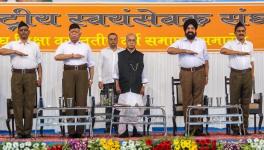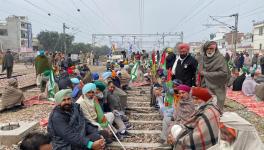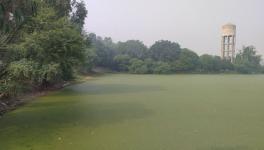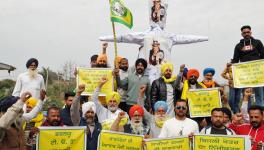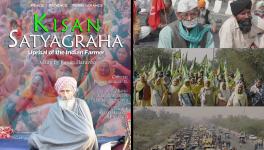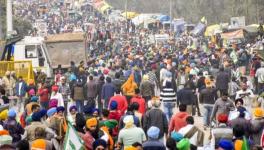Special: How Film and Music Connect Punjabis on Both Sides
Image Credit: Wikimedia Commons
“Khoon Khanne da vee ohee khoon Lahore da vee ohee,
Khoon Layalpur vaale Ludhiyane bolade
Sadde ekko hai zubaan, sadde virse vi ekko
Kitthon vakhkh ne Panjab eh siyaane bolade:
Saadde khoon vich vassada Panjab bolada.”
These lyrics from “Punjab”, a song from Pakistani Punjab, were composed and sung to express solidarity with India’s ongoing farmer movement. Seventy-four years after they were wrenched apart by Partition, the hearts of Punjabis on both sides of the border still beat as one, and this song is a beautiful glimpse of that shared sense of Punjab and Punjabiyat. It demonstrates how culture and mutual regard can overcome the barriers that those in power erect to divide lands and hearts. In Punjab, we never see the hostility that other parts of the country have towards Pakistan. The reason is the deep historical, social and cultural ties of Punjabis on both sides. Their rituals, customs, stories and beliefs are the same, too.
Punjabi littérateurs in Indian Punjab are taught the syllabus that universities in Pakistani Punjab follow, and vice versa. For nearly two decades, Punjabi newspapers in Indian Punjab have referred to Pakistani Punjab as “Lehanda” or West Punjab and Indian Punjab as “Chardha” or East Punjab, nicknames given by those who love Punjabi and Punjabi littérateurs. Newspapers in Chardha Punjab often publish authors from Lehanda Punjab, for Punjabi readers appreciate and demand their writings.
Punjabi film and music also play a significant role in connecting the Punjabis. Indian and Pakistani film and music, even commercials on TV, have always “borrowed” content from one another. Still, it is through their movies and music that the Punjabis in both countries have forged a real connection. Until the 1970s, TV sets across Indian Punjab would screen Pakistani films regularly. The older generations of Punjabis still recall the plot and songs of “Phere”, the first Punjabi film made after the creation of Pakistan. They cannot forget the 1970 film, “Heer-Ranjha”, remade several times since then. No conversation about Pakistani Punjabi movies is complete until they recall “Kartar Singh”, “Yakke Wali”, “Heer Sial”, and “Dulla Bhatti”. The song “Vaasta ae rabb da tu javin ve kabuva, chitthi mere dhole nun pahuchwain ve kabuva—in the name of god, take my letter to my lover, o pigeon”, from the movie “Dulla Bhatti”, is evergreen in Indian Punjab. The 1951 Pakistani Punjabi film “Channa Ve” features the song “Mundaya Sialkotia—boy from Sialkot” sung by Noor Jahan, virtually immortal in Indian Punjab. The 1970 Pakistani Punjabi film “Heer-Ranjha”, whose story and lyrics are by the famous Punjabi poet Ahmed Rahi and songs sung by Noor Jahan, have also achieved folk status in Indian Punjab.
After 1970, Pakistani films got banned in Indian Punjab cinema. When the younger generation of Indian Punjab watches old Pakistani movies over the internet today, they say—‘What fantastic movies we are missing out on!’ In Pakistan, the Imran Khan government barred the screening of Indian films two years ago, after relations between the two countries were at another all-time low. These days, cinema halls are closed in Pakistan due to the Covid-19 pandemic.
Pakistani Punjabi poet Afzal Sahir says, “The film industry of Pakistan is in crisis since several years. It is not producing good films even though there are large, luxurious cinema halls in Pakistan. Indian films are very popular here, and this drives the success of theaters. Earlier, only Hindi films from India were screened, but now, since good Punjabi films are being produced in India, those are also screened regularly. It is why, I feel, Pakistan cannot totally ban Indian films.”
No doubt, Punjabis in India prefer to watch Hindi rather than Punjabi films. It is because Indian Punjab has fewer good Punjabi films than Pakistani Punjab. Also, until 2002, India produced very few Punjabi movies. That year, the film, “Jee Aayan Nu”, with a budget of Rs. 5 crore—the biggest budget for an Indian Punjabi film at the time—was released to box office success. After “Jee Aayan…”, more Pakistani Punjabis began watching movies made in Indian Punjab. The exception is older Punjabi films made in Indian Punjab, such as “Chaman, the first post-Independence Punjabi film made in Indian Punjab, which gained tremendous viewership in Punjab.
Indian Punjabi cinema has always imitated Pakistani Punjabi cinema. When Pakistan started making films on Jatts (Jats), Indian Punjabis also made films on Jats. When Pakistan made action films based on romantic or classical love stories, Indian Punjabi cinema followed suit. The Punjabi movie “Chowdhary Karnail Singh”, released in India in 1964, is an exact copy of the Punjabi film “Kartar Singh”. It was released on Eid, 18 June 1959, in Pakistan.
Sultan Rahi and Mustafa Qureshi’s stellar film “Maula Jatt” was released in the late seventies. They say it earned as much as “Sholay”. The movie “Putt Jattan De”, an imitation of Maula Jatt, was released in 1983 in Indian Punjab. Two Indian Punjabi actors—Gaggu Gill and Yograj (the former cricketer)—were brought to the silver screen to imitate Pakistani actors Sultan Rahi and Mustafa Qureshi. Yograj disclosed in an interview that they were given specific instructions to imitate Rahi and Qureshi.
A remake of the 1998 Pakistani Punjabi film “Chudiyan”, the Punjabi film, “Majajan”, was released in Indian Punjab in 2007. (Funnily, even the title of this film, which means laughter, was taken from another just-released Pakistani Punjabi film). At least three Hindi and Punjabi films made in India were “inspired” by the 1970 Pakistani Punjabi film “Heer-Ranjha”. Other Indian Punjab films that copied Pakistani Punjabi films are “Dhi Rani”, “Sukhi Parivar”, “Daaj”, “Naukr Vohti Da”, “Badla Jatti Da”, and many more. Similarly, Pakistani Punjabi cinema copied Indian Punjabi films at times. A 1986 Indian Punjabi film, “Laung da Lishkara,” starring the famous actor-politician Raj Babbar and singer Gurdas Mann, was remade in Pakistan and released with the same title in 2000. It featured the famous Pakistani actors Shaan, Shafqat Cheema, Reema and Nargis.
The Partition is also a common theme in Pakistani and Indian Punjabi films. At times, Pakistani Punjabi cinema has sensitively portrayed Sikh-Muslim relationships from before and after the Partition. However, Pakistani film-makers do not give as much space as Indian Punjabis to the Partition, especially avoiding the bloodshed. The reason is that the foundations of Pakistani cinema are not as secular as in Indian Punjab. The 1959 film “Kartar Singh”, directed by Saifuddin Saif, is perhaps the best film on the Partition. Located in a fictional village in pre-Partition Punjab, whose Hindus, Sikhs and Muslims live together, the film presents positive Hindu and Sikh (especially Hindu) characters. However, it is rare for most Pakistani films on the Partition. In this movie, the stirring poem “Ajj Aakhan Waris Shah Nu” by Amrita Pritam is sung very soulfully by Inayat Hussain Bhatti.
The 2010 film “Channa Sachi Muchi”, a love story set in 1947 directed by Ijaz Bajwa, is one of the best new films made in Pakistan on Partition. This film gave new life to the weakened Pakistani film industry (named Lollywood after Lahore). Released in Indian Punjab and Australia, it featured the prominent Pakistani actors Muammar Rana, Saima Noor, Babar Ali, Hina, Naghma, Shafqat Cheema and Irfan Khoosat, the comedian. It is Indian Punjabi films that have not let go of the theme of Partition. (“Lahoriye”, “Sardar Mohammad”, “Chal Mere Putt” are recent examples.) The 2015 Punjabi film “English” is not on Partition, but is located in 1945 and portrays the culture of united Punjab and features an inspirational picture of Sikh-Muslim friendship.
Gurdas Maan and Divya Dutta acted in the 1999 Partition-themed film, “Shaheed-e-Mohabbat Buta Singh”. The director Manoj Punj has said it draws upon a true love story. Some Pakistani actors have also worked in Indian films. For instance, Veena Malik has acted in the Indian Punjabi film “Pind Di Kudi”.
A significant feature of Pakistani Punjabi films is that they often take Sikh characters and tell sublime stories about Muslim-Sikh friendships, even if set after 1947. (For example, “Puttar Jagge Da”). Generally, Sikh characters get assigned the role of comic relief, but some films such as “Malangi” and “Chann Variyam” are exceptions. Sikh characters are also positively portrayed in many television serials such as “Must Bhar Chawal”. These days in Pakistan, the popular serial “Ghuggi” has Sikh characters.
Many Punjabi singers are equally famous in both Punjabs. For instance, Mallika-e-Tarannum (queen of melody) Noor Jahan, Nusrat Fatah Ali Khan, Shaukat Ali, Mehdi Hassan, Ghulam Ali, Inayat Hussain Bhatti, Surendra Kaur, Prakash Kaur, Mahendra Kapoor, Mohd. Rafi, Gurdas Maan, Hans Raj Hans, Harbhajan Mann and Naseebo Lal have all broken the boundaries hoisted by Partition. These days, many young Punjabi singers from both sides are singing about togetherness and mutual affection.
The hearts of millions of Punjabis beat in unison despite the strife between India and Pakistan. Their connections of language and culture draw them closer. So, the desire to know and understand the Punjabs across their border lives on among the youth. Punjabis paid a heavy price for the Partition of 1947. Today, we must accept the essential role that Punjabis on both sides can play to improve relations between India and Pakistan. Pakistani Punjabi poet Iqbal Qaiser says, “We cannot ignore the role of music and films of both the Punjabs. Art, music and film play a vital role in connecting people. An immediate instance is the singers of Lehanda Punjab associating themselves with Chardha Punjab by singing songs in favour of the ongoing peasant movement in India. Punjab is really just Punjab. You can divide its land by drawing lines in it, but you cannot subdivide Punjabiyat.”
The author is a freelance journalist. The views are personal.
Get the latest reports & analysis with people's perspective on Protests, movements & deep analytical videos, discussions of the current affairs in your Telegram app. Subscribe to NewsClick's Telegram channel & get Real-Time updates on stories, as they get published on our website.










